fold seats AUDI RS7 SPORTBACK 2014 Owners Manual
[x] Cancel search | Manufacturer: AUDI, Model Year: 2014, Model line: RS7 SPORTBACK, Model: AUDI RS7 SPORTBACK 2014Pages: 292, PDF Size: 73.56 MB
Page 58 of 292
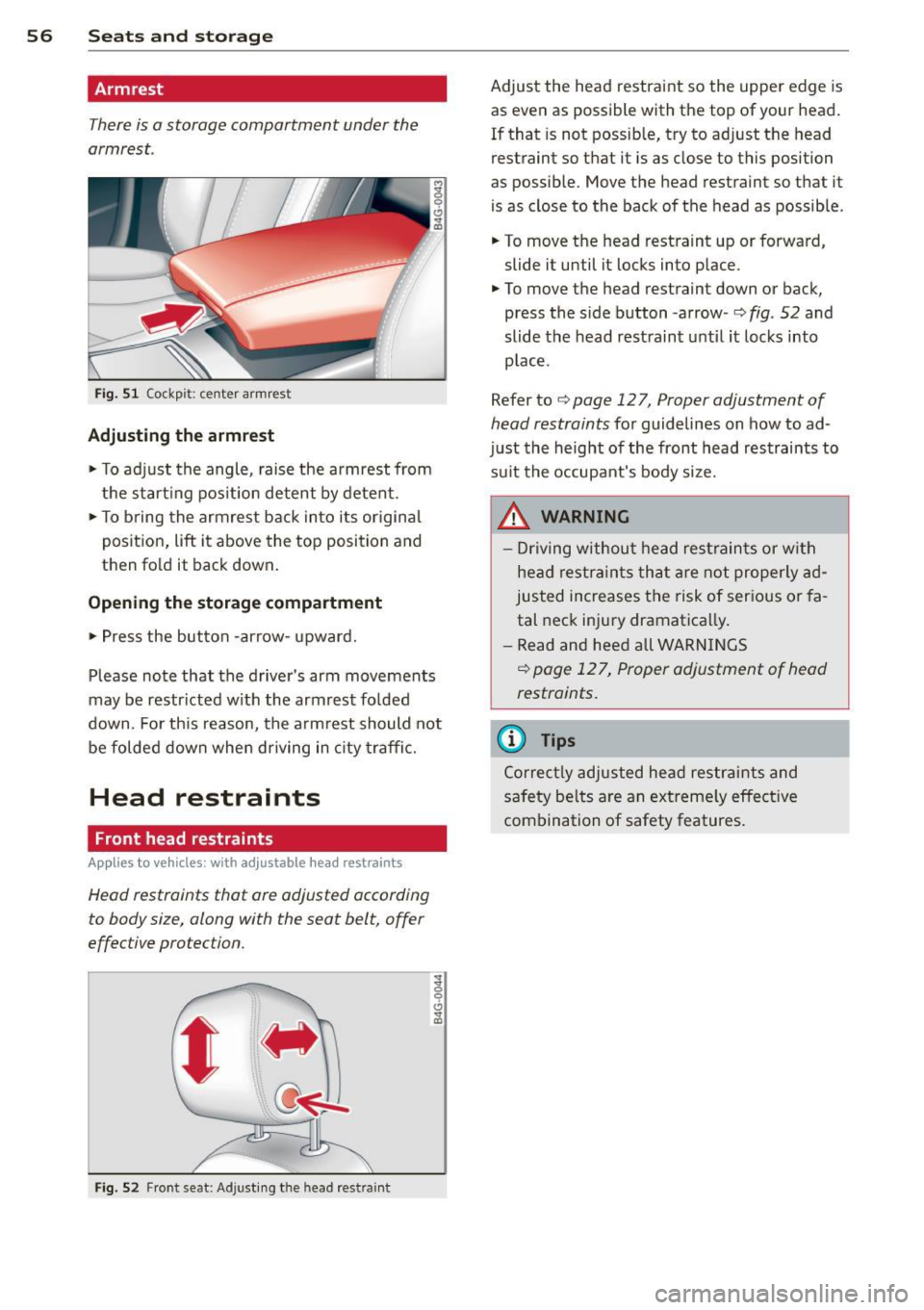
56 Seats and storage
Armrest
There is a storage compartment under the
armrest.
Fi g. 51 Cockp it: center armrest
Adjusting th e armrest
• To ad just the angle, raise the armrest from
the start ing pos ition detent by detent.
• To bring the armrest back into its original
position, lift it above the top position and
then fold it back down.
Opening th e storage compartment
• Press the button -arrow-upward.
Please note that the driver's arm movements
may be restr icted w ith the armrest fo lded
down. Fo r th is reason, the armrest should not
be folded down when driving in c ity traffic.
Head restraints
Front head restraints
App lies to vehicles: with adjustable head restrain ts
Head restraints that are adjusted according
to body size, along with the seat belt, offer
effective protection.
F ig . 52 Front seat: Adjust ing the head restra int
Adjust the head restraint so the upper edge is
as even as possible with the top of your head.
If that is not possible, try to adjust the head
restraint so that it is as close to this position
as possible. Move the head restraint so that it
is as close to the back of the head as possib le .
• To move the head restraint up or forward,
slide it until it locks into place.
• To move the head restraint down or back,
press the side button -arrow -
c::> fig. 52 and
slide the head restraint unt il it locks into
p lace.
Refer to
c::> page 12 7, Proper adjustment of
head restraints
for guidelines on how to ad
just the height of the front head restraints to
su it the occupant's body size.
_& WARNING
- Dr iving w ithou t head rest rain ts or with
head restra ints tha t a re not properly ad
justed increases the risk of ser ious or fa
tal neck injury dramatica lly.
- Read and heed all WARN INGS
c::> page 12 7, Proper adjustment of head
restraints.
(D Tips
Cor rect ly adjusted head restr aints and
safety be lts are an extreme ly effe ctive
combination of safety features.
-
Page 59 of 292
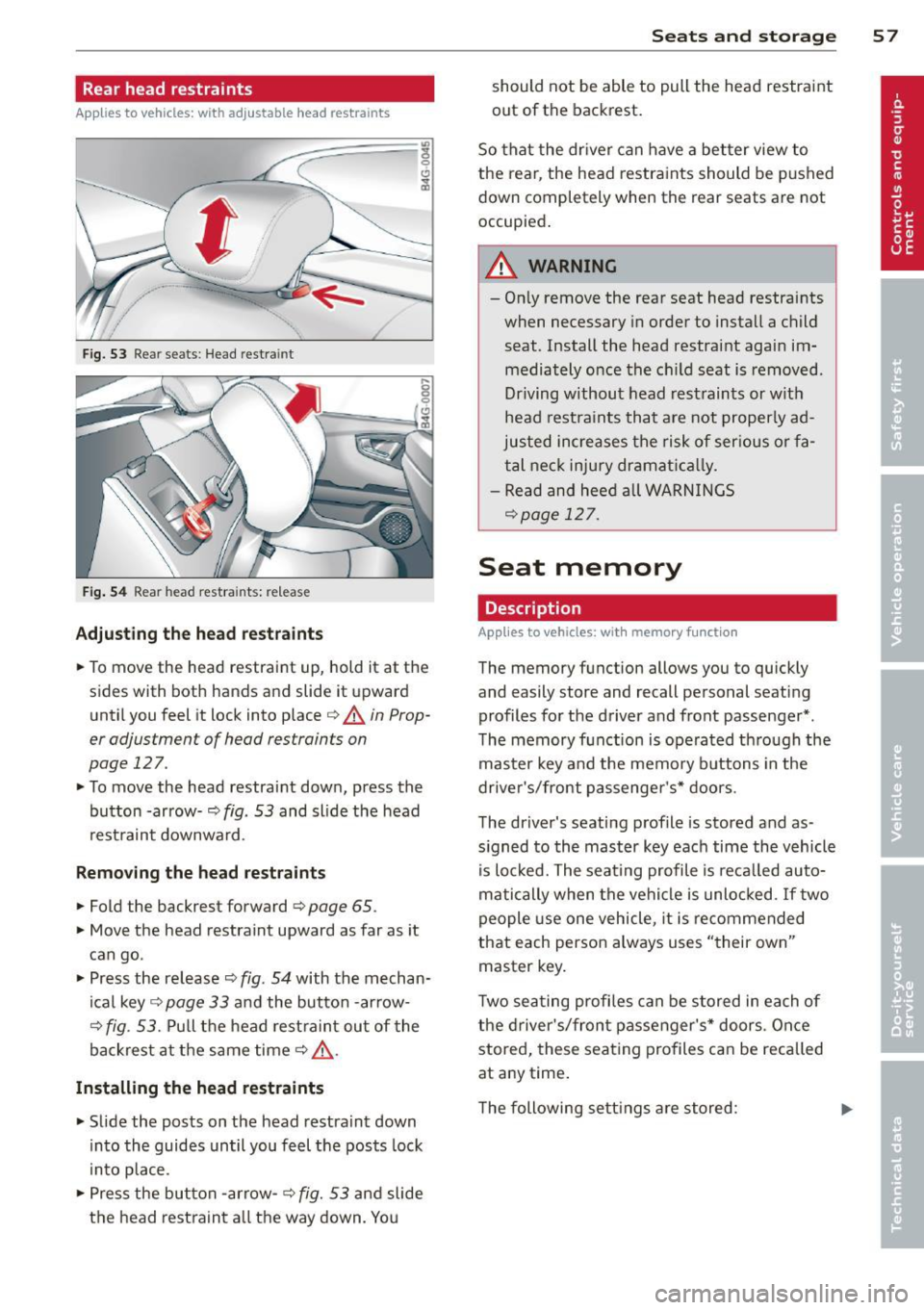
Rear head restraints
Applies to vehicles: with adj ustable head restraints
--
/
Fig. 53 Rear seats: Head restra int
Fig. 54 Rear head restra ints: re lease
Adjusting the head restraints
• To move the head restraint up, hold it at the
sides with both hands and slide it upward
until you feel it lock into place
¢ .&. in Prop
er adjustment of head restraints on
page 127.
• To move the head restraint down, press the
button -arrow-
q fig . 53 and sl ide the head
restraint downward .
Removing the head restraint s
• Fold the backrest forward ¢ page 65 .
• Move the head restraint upward as far as it
can go .
• Press the release¢
fig. 54 with the mechan
ical key ¢
page 33 and the button -arrow-
¢
fig. 53. Pull the head restraint out of the
backrest at the same time
q _&..
Installing the head restraints
• Slide the posts on the head restraint down
into the guides until you feel the posts lock
i nto place .
• Press the button -arrow-
¢ fig. 53 and slide
the head restraint a ll the way down. You
Seats and storage 57
should not be able to pull the head restraint
out of the backrest.
So that the driver can have a better view to
the rear, the head restraints should be pushed
down completely when the rear seats are not
occupied .
A WARNING
-On ly remove the rear seat head restraints
when necessary in order to install a child
seat. Install the head restraint again im mediately once the child seat is removed.
Driving without head restraints or with
head restraints that are not properly ad
justed increases the risk of serious or fa
tal neck injury dramat ically.
- Read and heed all WARNINGS
qpoge 127.
Seat memory
Description
Applies to vehicles: wit h memory function
The memory func tion allows you to quickly
and easily store and recall personal seating
profiles for the driver and front passenger* .
The memory function is operated through the
master key and the memory buttons in the
driver's/front passenger's* doors.
The driver's seating profile is stored and as
s igned to the master key each time the vehicle
is locked. The seating profile is recalled auto
matically when the vehicle is unlocked. If two
people use one vehicle, it is recommended
that each person always uses "their own"
master key.
Two seating profiles can be stored in each of
the driver's/front passenger's* doors. Once
stored, these seating profiles can be recalled
at any time .
The following settings are stored:
Page 67 of 292
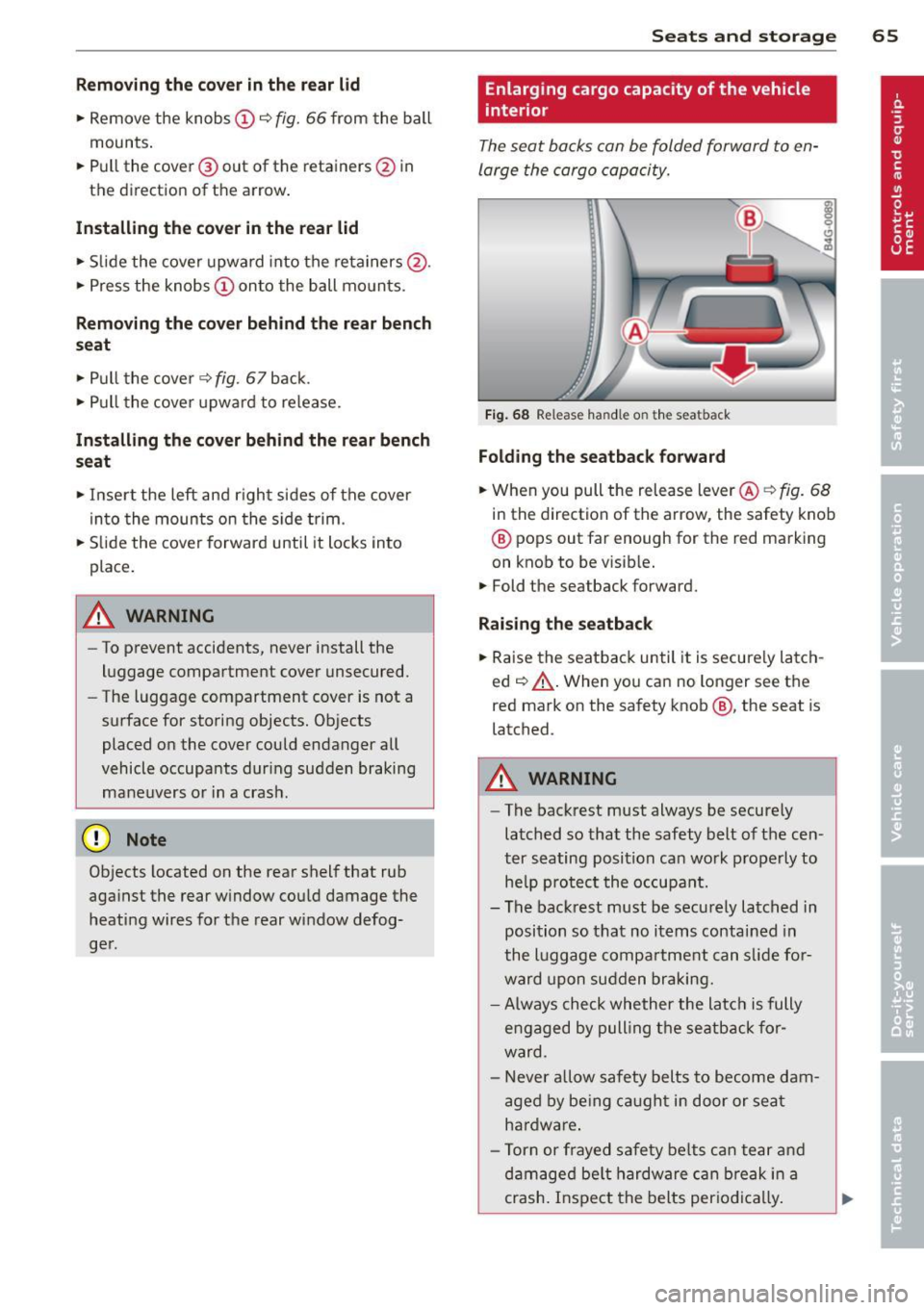
Removing the cover in the rear lid
• Remove the knobs CD c::> fig. 66 from the ball
mounts.
• Pull the cover @out of the retainers@ in
the direct ion of the arrow .
Installing the cover in the rear lid
• Slide the cover upward into the retainers @.
• Press the knobs
CD onto the ball mounts.
Removing the cover behind th e rear bench
seat
• Pull the cover ¢ fig. 67 back.
• Pull the cover upward to release.
Installing the cover behind the rear bench
seat
• Insert the left and right sides of the cover
into the mounts on the side trim .
• Slide the cover forward until it locks into
place .
A WARNING
-To prevent accidents, never install the
luggage compartment cover unsecured.
- The luggage compartment cover is not a
surface for storing objects. Objects
placed on the cover could endanger all
vehicle occupants during sudden braking
maneuvers or in a crash.
(D Note
Objects located on the rear shelf that rub
aga inst the rear window could damage the
heating wires for the rear window defog
ger .
Seats and storage 65
Enlarging cargo capacity of the vehicle
, interior
The seat backs can be folded forward to en
large the cargo capacity.
Fig. 68 Release handle on t he seatback
Folding the seatback forward
• When you pull the release lever @<=:> fig. 68
in the direction of the arrow, the safety knob
® pops out far enough for the red marking
on knob to be visib le.
.,. Fold the seatback forward.
Raising the seatback
.,. Raise the seatback until it is secure ly latch
ed¢ &,.. When you can no longer see the
red mark on the safety knob@, the seat is
latched .
_& WARNING
-
-The backrest must always be securely
latched so that the safety belt of the cen
ter seating position can work properly to he lp protect the occupant.
- The backrest must be securely latched in
position so that no items contained in
the luggage compartment can s lide for
ward upon sudden braking.
- Always check whether the latch is fully
engaged by pulling the seatback for
ward .
- N ever a llow safety belts to become dam
aged by being caught in door or seat
hardware .
- Torn or frayed safety belts can tear and
damaged be lt hardware can break in a
crash. Inspect the belts periodical ly.
Page 68 of 292
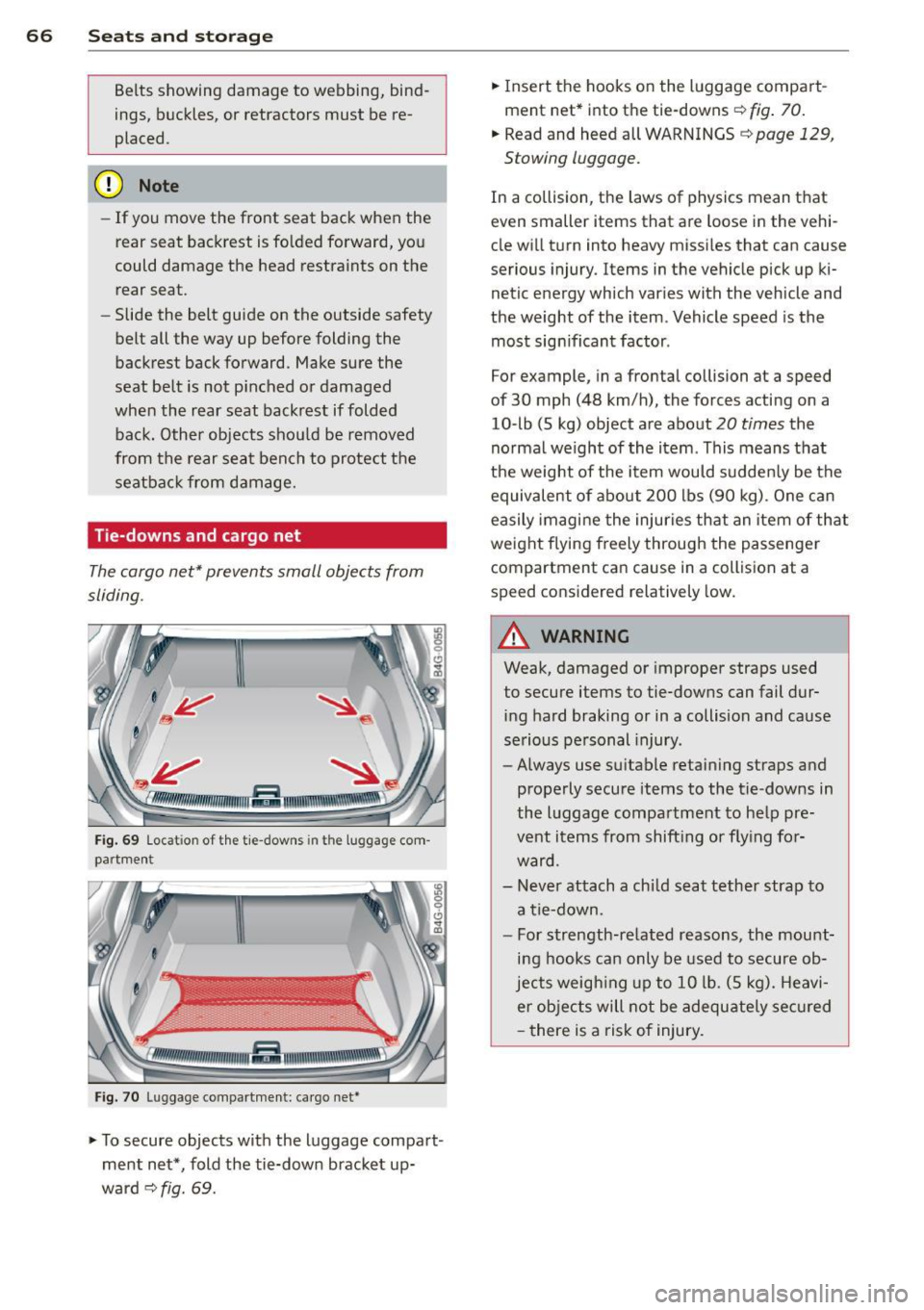
66 Seats and st o rage
Belts showing damage to webbing, bind
ings, buckles, or retractors must be re
placed.
(D Note
- If you move the front seat back when the
rear seat backrest is fo lded forward, you
could damage the head restraints on the
rear seat.
- Slide the belt guide on the outside safety
belt all the way up before folding the
backrest back forward. Make sure the
seat belt is not p inched or damaged
when the rear seat backrest if folded
back. Other objects shou ld be removed
from the rear seat bench to protect the
seatbac k from d amage.
Tie -downs and cargo net
The cargo net" prevents small objects from
sliding.
Fig . 69 Locat ion of the tie -downs in the luggage com
partment
Fig. 7 0 Luggage compartme nt: ca rgo net*
... To secure objects with the luggage compart
ment net*, fold the tie-down bracket up
ward
c:::> fig. 69.
... Insert the hooks on the luggage compart
ment net* into the tie-downs
c:::> fig. 70.
... Read and heed all WARNINGS c:::> page 129,
Stowing luggage.
In a collision, the laws of physics mean that
even smaller items that are loose in the vehi
cle will turn into heavy missi les that can cause
serious injury. Items in the vehicle pick up ki
netic energy which varies with the vehicle and
the weight of the item . Vehicle speed is the
most sign ificant factor .
For example, in a frontal collision at a speed
of 30 mph (48 km/h), the forces acting on a
10-lb (5 kg) object are about
20 times the
normal we ight of the item . This means that
the weight of the item would sudden ly be the
equivalent of abo ut 200 lbs (90 kg). One can
easily imagine the injuries that an item of that
weight flying freely through the passenge r
compartment ca n cause in a collision at a
speed considered relatively low.
A WARNING
-
Weak, damaged or improper straps used
to secure items to tie-downs can fail dur
ing hard braking or in a collision and cause
serious personal injury.
- Always use suitable retaining straps and
properly secure items to the tie-downs in
the l uggage compartment to help pre
vent items from shift ing or fly ing for
ward.
- Never attach a chi ld seat tether strap to
a tie-down.
- For strength-related reasons, the mou nt
ing hooks can only be used to secure ob
jects weigh ing up to 10 lb. (5 kg). Heavi
er objects will not be adequ ately sec ured
- there is a risk of injury.
Page 69 of 292
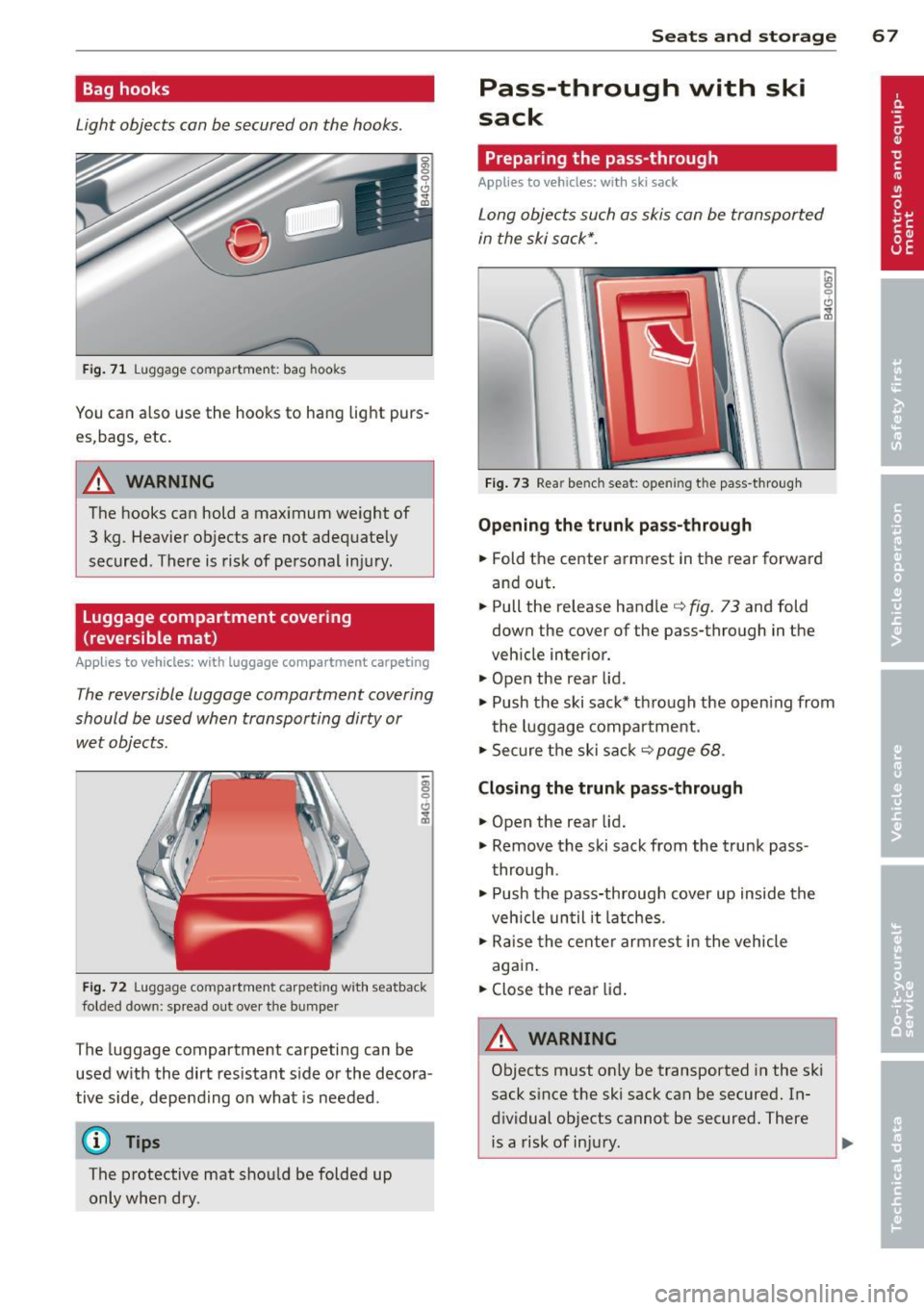
Bag hooks
Light objects can be secured on the hooks.
Fig. 71 Luggage compartme nt: bag hooks
You can also use the hooks to hang light purs
es,bags, etc.
A WARNING
The hooks can hold a max imum weight of
3 kg. Heavier objects are not adequately
secured. There is risk of personal injury .
Luggage compartment covering
(reversible mat )
Applies to vehicles: with luggage compartment carpeting
The reversible luggage compartment covering
should be used when transporting dirty or
wet objects.
Fig. 72 Luggage compartment carpeting with seatback
folded dow n: sp read out over the bumper
The lugg age compartment carpeting can be
used w ith the dirt resistant s ide or the decora
tive side, depending on what is needed .
@ Tips
The protective mat should be folded up
only when dry.
Seats and storage 67
Pass-through with ski
sack
Preparing the pass-through
Applies to vehicles: wi th ski sack
Long objects such as skis can be transported
in the ski sack*.
Fig. 73 Rear bench seat: opening the pass -through
Opening the trunk pass-through
.. Fold the center armrest in the rear forward
and out .
.. Pull the release handle
c::> fig. 73 and fold
down the cover of the pass-through in the
vehicle interior.
.. Open the rear lid .
.,. Push the ski sack* through the opening from
the luggage compartment.
.,. Secure the ski sack
c::> page 68 .
Closing the trunk pass-through
.,. Open the rear lid .
.,. Remove the ski sack from the trunk pass
through .
.. Push the pass-through cover up inside the
veh icle until it latches .
.,. Raise the center armrest in the vehicle
again.
.. Close the rear lid.
A WARNING ~
Objects must only be transported in the ski
sack since the ski sack can be secured. In
dividual objects cannot be secured. There is a risk of injury .
Page 127 of 292
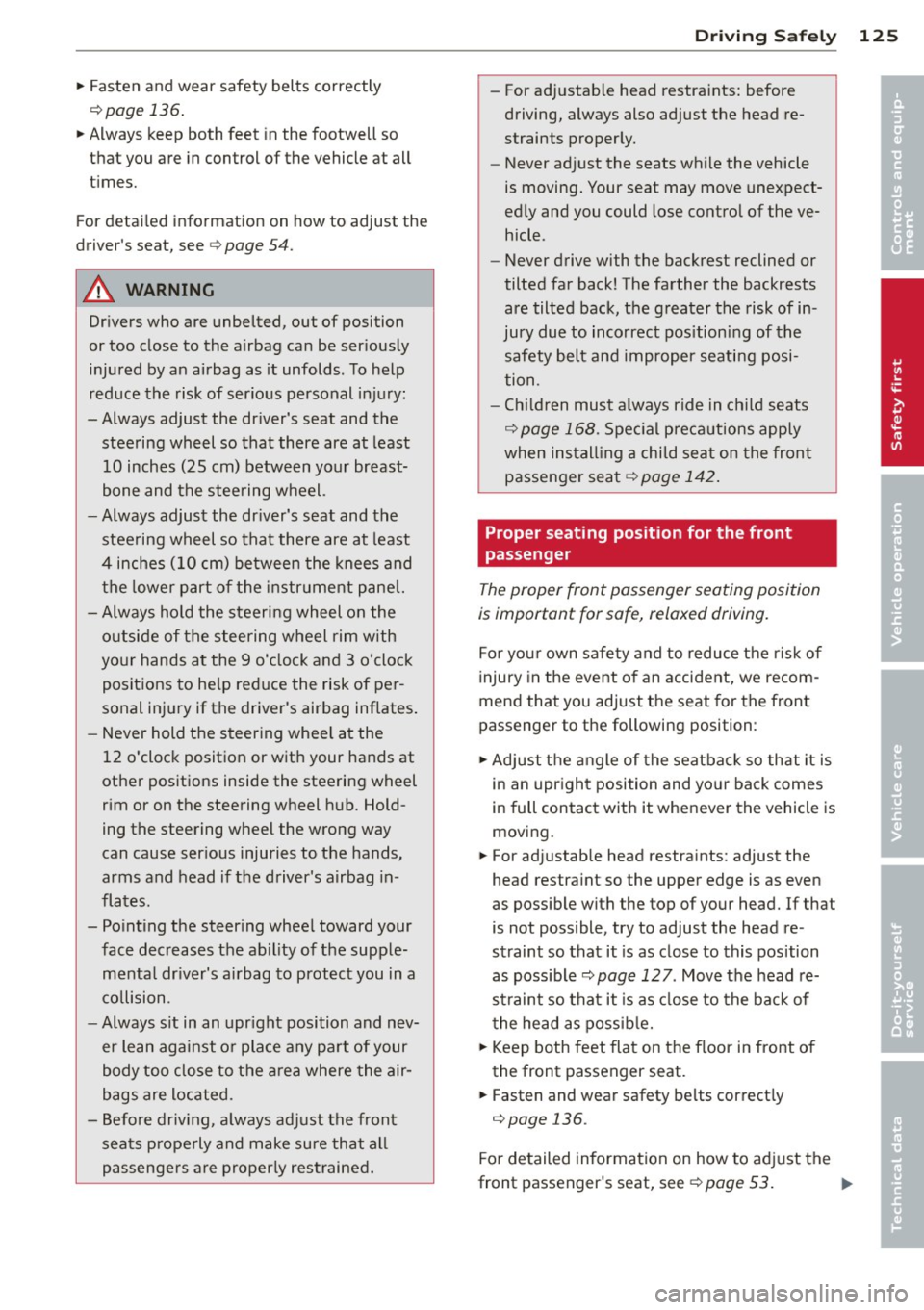
~ Fasten and wear safety belts correctly
¢page 136.
~ Always keep both feet in the footwell so
that you are in control of the vehicle at all
times.
For detailed information on how to adjust the
driver's seat, see
¢ page 54 .
A WARNING
Drivers who are unbelted, out of position
or too close to the airbag can be seriously
injured by an airbag as it unfolds. To help
reduce the risk of serious personal injury:
- Always adjust the driver's seat and the
steering wheel so that there are at least
10 inches (25 cm) between your breast
bone and the steering wheel.
- Always adjust the driver's seat and the
steering wheel so that there are at least
4 inches (10 cm) between the knees and
the lower part of the instrument panel.
- Always hold the steering wheel on the
outside of the steering wheel rim with
your hands at the 9 o'clock and 3 o'clock
positions to help reduce the risk of per
sonal injury if the driver's airbag inflates.
- Never hold the steering wheel at the
12 o'clock position or with your hands at
other positions inside the steering wheel
rim or on the steering wheel hub . Hold
ing the steering wheel the wrong way
can cause serious injuries to the hands, arms and head if the driver's airbag in
flates.
- Pointing the steering wheel toward your
face decreases the ability of the supple
mental driver's airbag to protect you in a
collision .
- Always sit in an upright position and nev
er lean against or place any part of your
body too close to the area where the air
bags are located.
- Before driving, always adjust the front
seats properly and make sure that all
passengers are properly restrained.
Driving Safely 125
-For adjustable head restraints: before
driving, always also adjust the head re
straints properly.
- Never adjust the seats while the vehicle
is moving. Your seat may move unexpect
edly and you could lose control of the ve hicle .
- Never drive with the backrest reclined or
tilted far back! The farther the backrests are tilted back, the greater the risk of in
jury due to incorrect positioning of the safety belt and improper seating posi
tion .
- Children must always ride in child seats
¢ page 168. Special precautions apply
when installing a child seat on the front
passenger seat ¢
page 142.
Proper seating position for the front
passenger
The proper front passenger seating position
is important for safe, relaxed driving.
For your own safety and to reduce the risk of
injury in the event of an accident, we recom
mend that you adjust the seat for the front
passenger to the following position :
~ Adjust the angle of the seatback so that it is
in an upright position and your back comes
in full contact with it whenever the vehicle is
moving.
~ For adjustable head restraints: adjust the
head restraint so the upper edge is as even
as possible with the top of your head. If that
is not possible, try to adjust the head re
straint so that it is as close to this position
as possible
¢ page 127. Move the head re
straint so that it is as close to the back of
the head as possible.
~ Keep both feet flat on the floor in front of
the front passenger seat.
~ Fasten and wear safety belts correctly
¢ page 136.
For detailed information on how to adjust the
front passenger's seat, see
¢ page 53. .,..
•
•
Page 128 of 292
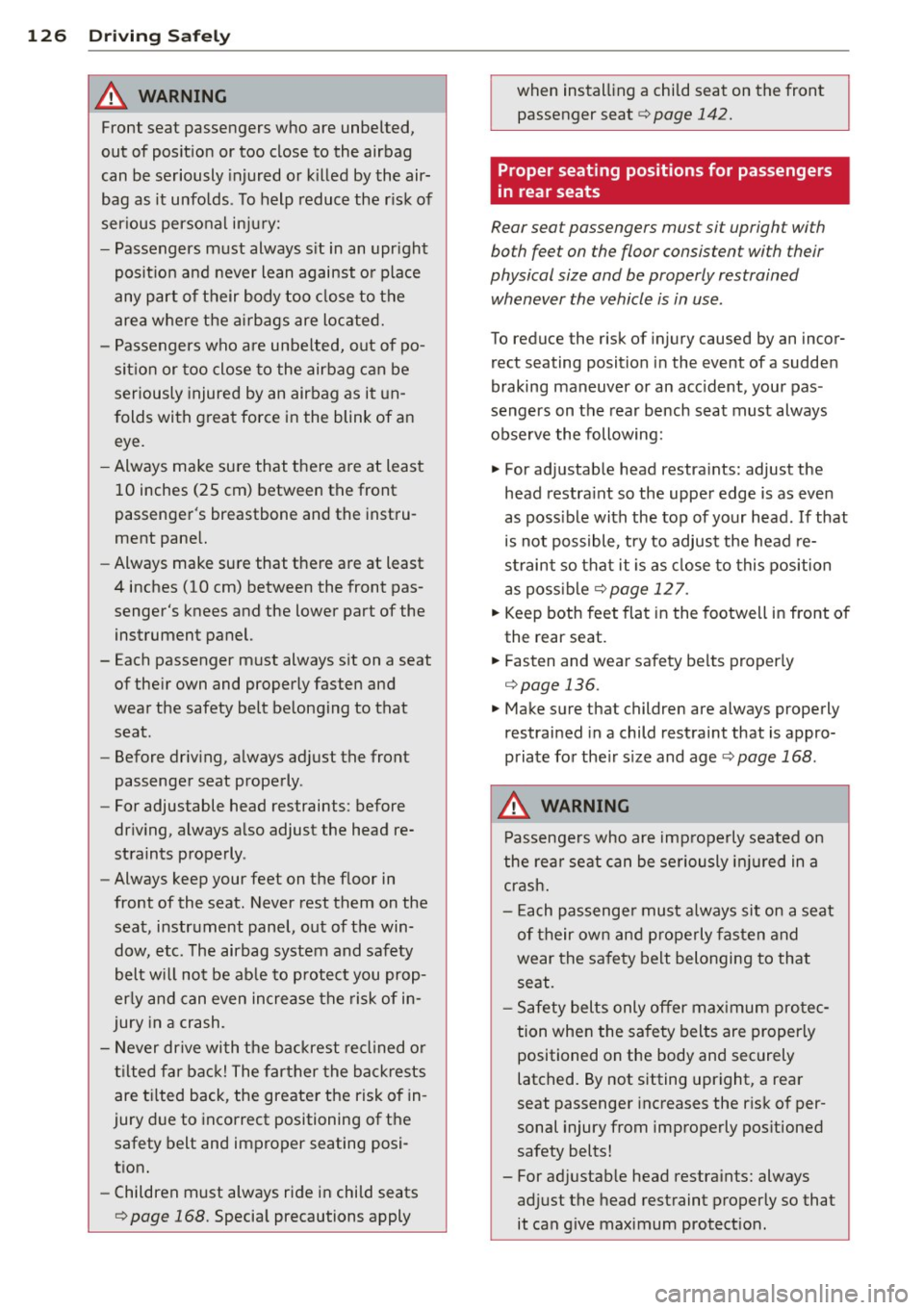
126 Driving Saf ely
A WARNING
Front seat passengers who are unbelted,
out of position or too close to the airbag
can be seriously injured or k illed by the air
bag as it unfolds . To help reduce the r isk of
ser ious personal injury:
- Passengers must always s it in an upr ight
posit ion and never lean against or place
any part of their body too close to the
area where the airbags are located.
- Passengers who are unbelted, out of po
sit ion or too close to the airbag can be
seriously injured by an airbag as it un
folds with great force in the blink of an eye.
- Always make sure that there are at least
10 inches (25 cm) between the front
passenger's breastbone and the instru
ment pane l.
- Always make sure that there are at least
4 inches (10 cm) between the front pas
senger's knees and the lower part of the
instrument panel.
- Each passenger must always sit on a seat of the ir own and properly fasten and
wear the safety belt be longing to that
seat.
- Before driving, always adjust the front
passenger seat properly .
- For adjustable head restraints: before
dr iv ing, always also adjust the head re
straints properly .
- Always keep your feet on the floor in
front of the seat. Never rest them on the
seat, instrument panel, out of the win
dow, etc. The airbag system and safety
belt w ill not be able to protec t you prop
erly and can even increase the risk of in
jury in a crash.
- Never drive with the backrest recl ined or
t ilted far bac k! The farther the back rests
are t ilted back, the greater the risk of in
jury d ue to incorrect positioning of the
safety belt and improper seating posi
t ion.
- Children must always ride in child seats
¢
page 168. Specia l precautions apply
-
when instal ling a child seat on the front
passenger seat¢
page 142.
Proper seating positions for passengers
in rear seats
Rear seat passengers must sit upright with
both feet on the floor consistent with their
physical size and be properly restrained whenever the vehicle is in use .
To reduce the risk of in jury caused by an incor
rect seating position in the event of a sudden
braking maneuver or an accident, your pas
sengers on the rear bench seat must always
observe the following:
.,. For adjustab le head restra ints: adjust the
head restra int so the upper edge is as even
as poss ible with the top of your head. If that
is not possible, try to adjust the head re
straint so that it is as close to this position
as poss ible
c;, page 127.
.,. Keep both feet flat in the footwell in front of
the rear seat .
.,. Fasten and wear safety belts proper ly
c;, page 136.
.,. Make sure that children are always properly
restrained in a child restraint that is appro
priate fo r the ir s ize and age
c::;, page 168 .
A WARNING
-Passengers who are imp roperly seated on
the rea r seat can be se riously in jured in a
crash.
- Each passenge r must always sit on a seat
of their own and p roperly fasten and
wear the safety belt belonging to that
seat.
- Safety belts only offer maximum pro te c
tion when the safety belts are properly
positioned on the body and securely
latched. By not sitting upright, a rear
seat passenger increases the r isk o f per
sonal injury from improperly pos itioned
safety belts!
- For ad justab le head restra ints: always
adjust the head restraint properly so that it can g ive maximum protect ion.
Page 154 of 292
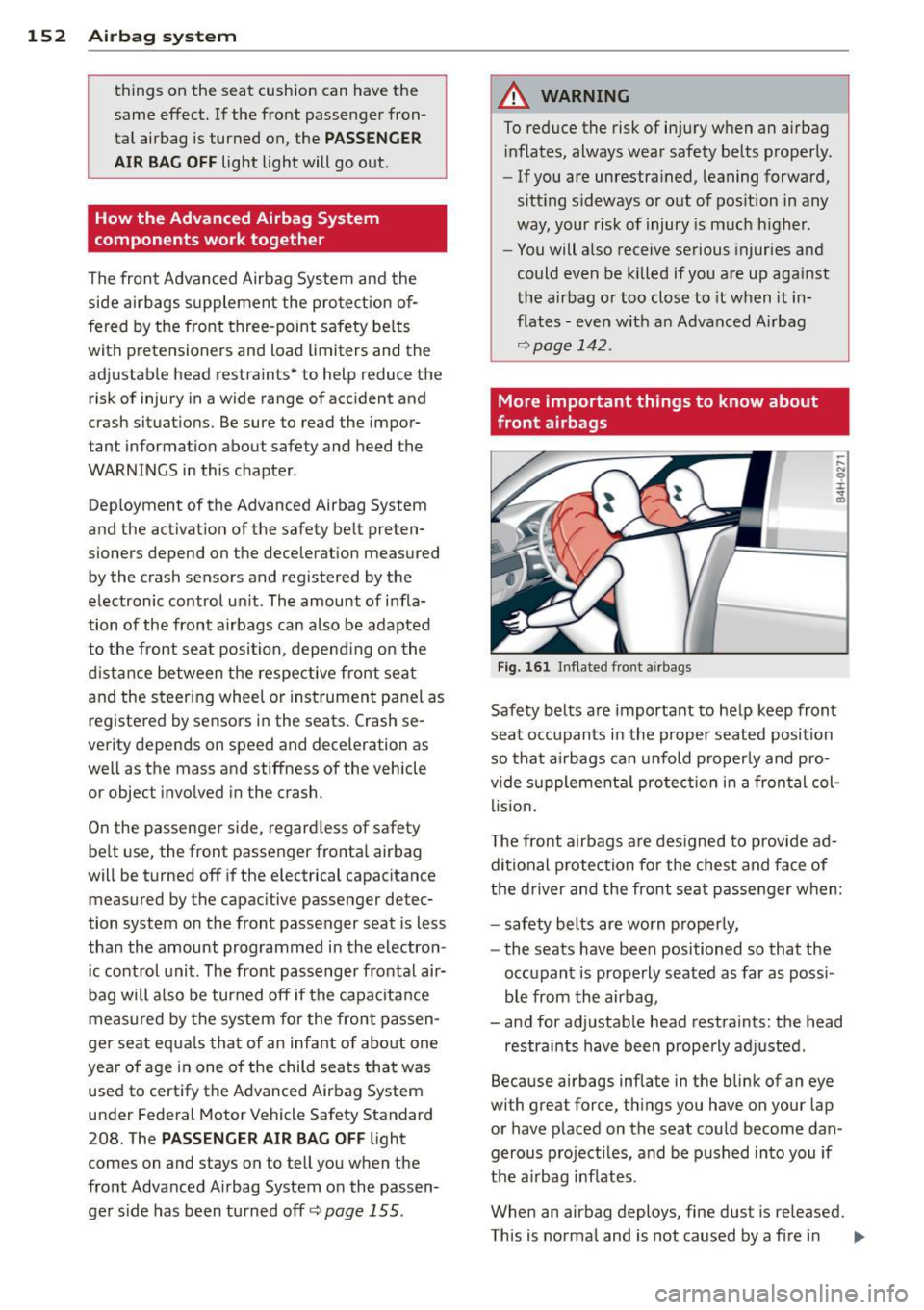
152 Airbag system
things on the sea t cushion can have the
same effect. If the front passenger fron tal airbag is turned on, the
PASSENGER
AIR BAG OFF
light light will go out .
How the Advanced Airbag System
components work together
The front Advanced Airbag System and the
side airbags supplement the protection of
fered by the front three -point safety be lts
with pretensioners and load limiters and the
adj ustab le head restraints* to help reduce the
risk of inju ry in a wide range of accident and
crash situa tions. Be sure to re ad the impor
tan t information abou t safe ty and heed the
WARNINGS in this chapter .
Dep loyment of the Advanced Airbag System
and the activat ion of the safety bel t preten
sioners depend on the decelera tion measured
by the crash sensors and registered by the
e lectronic control un it . The amount of i nfla
tion of the front airbags can also be adapted to the front sea t position , depend ing on the
d istance between t he respective front seat
and the steering wheel o r instrument pa nel as
registered by sensors in the seats. Crash se
ver ity depends on speed and dec elerat ion as
well as the mass and st iffness of the vehicle
or objec t invo lved in the crash .
On the passenge r side, regard less of safety
be lt use, the front passenger fronta l a irbag
will be turned off if the e lectrical capacitance
measured by the capac itive passenger de tec
tion system on the front passenger seat is less
than the amount programmed in the electron
i c co ntrol unit . The front passenger frontal air
bag will a lso be turned off if the capa cita nce
measured by the system for the front passen
ge r seat eq ua ls tha t of an infant of abo ut one
yea r of age in one o f the child sea ts that was
used to cert ify the Advanced Airbag System
under Federal Motor Vehicle Safety Standard
208. The
PASSENGER AIR BAG OFF li ght
comes on and stays on to tell you when the
front Advanced A irbag System on the passen
ge r side has been turned off~
page 155 .
A WARNING
-To reduce the risk of injury w hen an a irbag
in flates, always wear safety be lts p roperly.
- If you are unrestra ined, leaning fo rward,
sitt ing s ideways or out of pos ition in any
way, your risk of injury is much h igher .
- You will a lso receive se rious injuries and
could even be killed if you a re up aga inst
the airbag o r too close to it when it in
flates - even w ith an Advanced A irb ag
r:::> page 1 4 2 .
More important things to know about
front airbags
Fig . 1 61 In flated fro nt a irbags
Safety belts a re important to he lp keep front
seat o ccupants in the proper seated position
so that a irbags can unfold properly and pro
v ide s upplementa l pro te cti on in a fron tal col
li sion .
T he front airbags are des igned to provide ad
di tional p rotection fo r the ches t and face of
the driver a nd the front seat passenger w hen:
- safety belts are worn properly,
- the seats have bee n positioned so that the
occupant is properly seated as far as poss i
b le from the airbag ,
- and for ad justab le head restra ints: the head
restrai nts have been properly ad justed.
Beca use airbags inflate in the blink of an eye
with great force, th ings you have on your lap
or have p laced on the seat cou ld become dan
gerous projecti les, and be p ushed in to you if
t h e a irbag inflates .
When an airbag deploy s, fine dust is re leased.
This is norma l and is not caused by a f ire in ..,.
Page 155 of 292
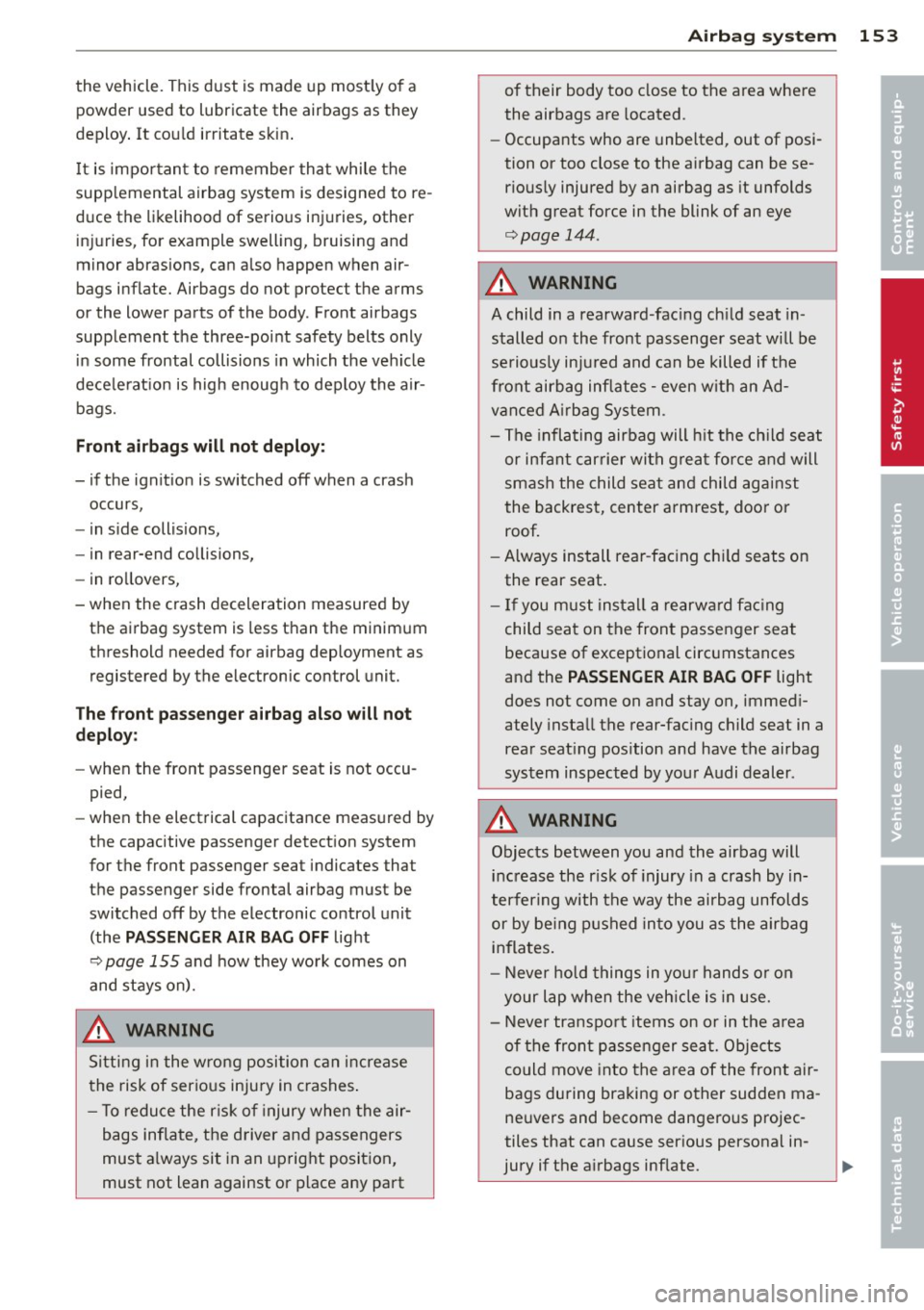
the vehicle. This dust is made up most ly of a
powder used to lubricate the airbags as they
deploy . It cou ld irritate skin .
It is importan t to remember that while the
supplemental airbag system is designed to re
duce the likelihood of serious injuries , other
in ju ries, for example swell ing, bruising and
minor abrasions, can also happen when air
bags inflate. Airbags do not protect the arms
or the lower parts of the body . Front airbags
supplement the three-poi nt safety belts only
i n some frontal collisions in which the vehicle
decelerat ion is high enough to deploy the air
bags.
Front airbags will not deploy:
- if the ignit ion is switched off when a crash
occurs,
- in s ide collisions,
- in rear-end collisions,
- in ro llovers,
- when the crash deceleration measured by
the airbag system is less than the minimum
threshold needed for airbag deployment as
registered by the electronic control unit.
Th e front pa sseng er airbag al so will not
d e plo y:
-when the front passenger seat is not occu
pied,
- when the electrical capacitance measured by
the capacitive passenger detect ion system
for the front passenger seat indicates that
the passenger side frontal airbag must be
switched off by the electronic control unit (the
P ASSENGER AIR BAG OFF light
¢ page 155 and how they wo rk comes on
and stays on).
A WARNING
Sitting in the wrong position can increase
the risk of serious injury in crashes .
- To reduce the r isk o f injury when the air
bags inflate, the driver and passengers
must a lways sit in an upright position,
must not lean against or place any part
A irbag system 153
of their body too close to the area where
the airbags are located.
- Occupants who are unbelted, out of posi
tion or too close to the airbag can be se
riously injured by an airbag as it unfolds
with great force in the blink of an eye
¢page 144.
A WARNING
A child in a rearward-fac ing ch ild seat in
stalled on the front passenger seat will be
se riously injured and can be killed if the
front airbag inflates - even w ith an Ad
vanced A irbag System.
- The inflating airbag will h it the ch ild seat
or infant carrier with great fo rce and will
smash the child seat and child against
the backrest, center armrest, doo r or
roof.
- Always install rear -facing chi ld seats on
the rear seat.
- If you must install a rearward fac ing
child seat on the front passenger seat
because of exceptional circumstances
and the PASS ENG ER AIR BAG OFF light
does not come on and stay on, immed i
ately insta ll the rear-facing child seat in a
rea r seat ing pos ition and have the airbag
system inspected by your Audi dealer .
A WARNING
Objects between you and the airbag will
increase the r isk of injury in a crash by in
terfering with the way the ai rbag unfolds
or by be ing p ushed into you as the airbag
inflates.
- Neve r hold things in yo ur hands o r on
your lap when the veh icle is in use.
- Never transpo rt items on or in the a rea
of the front passenger seat. Objects
co uld move into the area of the front air
bags during braking or other sudden ma
neuvers and become dangero us projec
tiles that can cause ser ious personal in
jury if the a irbags inf late.
•
•
-
-